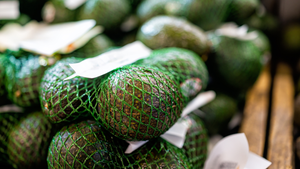CALIFORNIA 5-A-DAY PROGRAM IS SET TO TARGET HISPANICSCALIFORNIA 5-A-DAY PROGRAM IS SET TO TARGET HISPANICS
LOS ANGELES -- California's Hispanic population, its fastest growing segment, is eating less and less produce each year.This has not only produce marketing implications, but health care implications too, state health officials say.In a move to combat the decline, a new 5-a-Day promotional program targeted at Hispanics is set to be launched Sept. 16 at a Los Angeles unit of Dublin, Calif.-based Lucky
September 12, 1994
TONY SPLEEN
LOS ANGELES -- California's Hispanic population, its fastest growing segment, is eating less and less produce each year.
This has not only produce marketing implications, but health care implications too, state health officials say.
In a move to combat the decline, a new 5-a-Day promotional program targeted at Hispanics is set to be launched Sept. 16 at a Los Angeles unit of Dublin, Calif.-based Lucky Stores.
The launch coincides with national 5-a-Day Week, Sept. 11 to 17, and with the release of a new report on the dietary practices of Californians. The research shows a further decline in produce consumption among the state's Hispanic population, organizers of the new 5-a-Day program said.
The new program, administered by the California Department of Health Services in Sacramento and the California Public Health Foundation in Berkeley, is being funded with a two-year federal grant of $150,000. It is called the California Latino 5-a-Day Program.
"We're trying to leverage that money as much as possible," said Sam Vega, marketing director of the program. "But we're really going to need support from the industry in order to develop the other elements of the program like the public service announcements."
Vega said organizers hope to generate enough support for the program so that it will develop a life of its own once funding runs out in 1996.
"We're hoping to instill enough continuity so the campaign will be able to continue with alternative sources of funding," he said.
The program is the second in what organizers hope could be a series of 5-a-Day campaigns targeting specific population groups. The first such program, targeting children, was launched last year and has received in excess of $180,000 from the produce industry.
The 5-a-Day message was originally designed by the California Department of Health Services in the 1980s to encourage state residents to consume five servings of produce daily in an effort to improve their health.
The program was so successful that the 5 a Day for Better Health Foundation, Newark, Del., was formed to send the message nationally with the support of industry and the National Cancer Institute, Bethesda, Md.
"We want to complement the national 5-a-Day campaign by being niche players and targeting specific groups of people," said Vega. "For example, there is not currently a focused effort by the national campaign on the Spanish-speaking population. We're trying to fill that void."
Studies conducted by the state in the late 1980s documented what Vega called the start of the downward consumption trend among Hispanics, which make up 25% of the state's population.
"It's a much more dramatic trend than we're seeing in other population segments," said Vega. The most recent data available showed an 8% increase in produce consumption among the state's general population between 1989 and 1991, while consumption among Hispanics declined 18%.
The new study, which looks at consumption patterns between 1991 and 1993, is expected to show the same trend, Vega said.
Vega said that fruits and vegetables have traditionally been a major part of the Hispanic diet. Studies show, however, that upon their arrival in the United States, Hispanics typically adopt an American diet, which is high in fat and low in fiber. As a result, their consumption of produce quickly declines, resulting in an increase in the risk of diet-related illness, Vega said.
This trend could have "a major impact on the state's health care system," Vega said.
The new 5-a-Day program is a way to reach out to the Hispanic community since it does not respond to most existing 5-a-Day messages because they do not feature the Spanish language or Hispanic images, Vega said.
The centerpiece of the program will be a Spanish-language guide book, which explains the importance of eating five daily servings of produce and provides tips for increasing consumption.
Vega said the campaign plans to produce 100,000 books to be distributed to supermarkets and community and nonprofit agencies. Future phases of the program include media outreach, radio and television public service announcements and special events to promote the 5-a-Day message.
About the Author
You May Also Like




